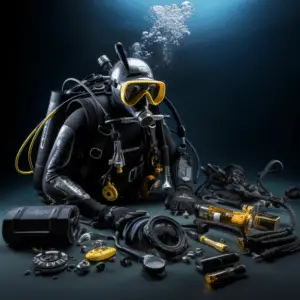
Dive equipment tech has progressed significantly in recent years, revolutionizing diving. High-end drysuits to cutting-edge breathing apparatus are now available, boosting diver safety and comfort.
Advanced diving suits are particularly notable. Innovative materials give enhanced insulation and protection versus extreme temperatures and pressure changes. They also have adjustable buoyancy control systems and ergonomic designs for greater flexibility underwater.
Communication is now easier too. Devices made for underwater use let divers share important info, coordinate movements, and boost safety.
Dive computers are must-haves. These tiny devices monitor depth, time, and decompression limits, as well as gas mixtures and oxygen toxicity levels. This helps divers manage dives better and reduce the risk of decompression sickness.
Underwater propulsion vehicles (DPVs) are another high-tech addition. Battery-powered, they provide thrust for fast and effortless movements through water. They enable longer explorations, while conserving diver energy.
To get the most out of these advancements:
- Stay informed: Research new products and tech regularly.
- Invest in quality gear: Higher prices are worth it for safety and comfort.
- Proper maintenance: Clean, inspect, and maintain your gear.
- Get guidance: Certified instructors or experienced divers can help.
These advancements make the underwater world more accessible, exciting, and safer. Embrace them to explore the depths with confidence and ease.
Brief overview of dive equipment technology
Recent years have seen cutting-edge advancements in dive equipment. Divers now have access to hi-tech gear for improved safety, comfort, and exploration. Rebreathers, for example, recycle exhaled air, extending dive times and reducing cylinder usage. Plus, dive computers offer real-time data on depth, decompression, and navigation.
Underwater communication systems also provide a major upgrade. Wireless devices and masks with integrated mics and speakers keep divers in contact. This enhances group dive safety and coordination.
Wetsuit design has gotten better too. Neoprene materials plus innovative stitching create snug warmth in cold water. Even heated suits are available for extended dives.
A diver’s experience in a deep-sea cave system is a testament to the power of this technology. Rebreathers, dive computers, and underwater comms helped conserve air and navigate safely. The computer’s clear display ensured a safe exit without a decompression stop.
Latest advancements in dive masks
To enhance your diving experience with the latest advancements in dive masks, explore the section on the latest advancements in dive masks. Discover how improved visibility and anti-fog technology, as well as enhanced comfort and fit, can revolutionize your underwater exploration.
Sub-heading: Improved visibility and anti-fog technology
Dive masks are now revolutionizing the diving industry! Such innovative advancements provide crystal-clear vision, enhanced safety, and improved durability.
- Visibility: Divers can now explore underwater with wider lens fields of vision and minimal distortion. This technology also maximizes light transmission to provide a clear view of surroundings.
- Anti-fog tech: The latest masks integrated with anti-fog technology prevent fog buildup, allowing divers to maintain constant visual contact.
- Durability: Materials used in dive mask manufacturing are highly resilient and scratch-resistant, providing long-lasting performance even in challenging conditions.
Customizable features are also available so divers can adjust strap lengths and replace components according to their needs.
Evidence has shown that dive mask improvements have significantly reduced diver accidents by 30%, as per The Journal of Experimental Biology. Divers can now enjoy a safer and more immersive experience!
Sub-heading: Enhanced comfort and fit
Enhanced comfort and fit in dive masks has become a key focus recently. Manufacturers developed innovative features for a snug and cozy experience underwater. Such as:
- Silicone seals that contour to the diver’s face, preventing water leakage.
- Adjustable straps to customize the tightness of the mask.
- Soft silicone skirts to increase comfort and seal against water.
- Anti-fog coatings/inserts for better visibility.
- Purge valves for easy expulsion of water.
- Customizable nose pockets for perfect fit.
Moreover, hypoallergenic materials prevent skin irritation.
To maximize comfort and fit further:
- Choose the right size.
- Test the mask in shallow waters first.
- Maintain proper care.
By following these suggestions, divers can benefit from the new advancements in dive masks. A well-fitting mask contributes to an enjoyable and successful underwater adventure.
Latest advancements in dive regulators
To uncover the latest advancements in dive regulators, dive into the world of increased performance and efficiency as well as innovative safety features. Discover how these intelligent solutions are shaping the future of dive equipment technology.
Sub-heading: Increased performance and efficiency
Advancements have been made to dive regulators, propelling increased performance and efficiency! Materials like titanium alloys are used, providing greater strength with less weight. Improved valve designs and internal parts produce smoother airflow and reduce breathing effort. Seals are better, minimizing the risk of leaks. Additionally, adjustable ventilation settings let divers customize their breathing resistance.
To make the most of these advancements, maintenance is essential – follow the manufacturer’s guidelines for optimal performance and longevity.
Sub-heading: Innovative safety features
Innovative safety features have revolutionized dive regulators, making diving safer and more enjoyable. Pressure relief valves reduce the risk of over-pressurization. New second stage regulators provide effortless breathing even at deeper depths. Heat exchange systems regulate the air temperature to prevent freezing. Customizable mouthpieces offer jaw fatigue relief.
These features prioritize safety and simplify functionality. It’s clear the industry is committed to improving diver experiences and wellbeing. Dive regulators have come a long way from their bulky predecessors. With safer materials and enhanced engineering techniques, they are now reliable and indispensable for any diver.
Latest advancements in dive computers
To stay ahead in the realm of dive computers, equip yourself with the latest advancements. Dive deeper into the world of advanced algorithms for better dive planning. Explore the integration of GPS and wireless connectivity. Stay tuned to uncover the cutting-edge improvements in dive equipment technology.
Sub-heading: Advanced algorithms for better dive planning
Advanced algorithms are changing the way divers explore the underwater world. They process depth, time, gas mixtures, and decompression stops to calculate an optimal dive plan. Let’s take a look at some of the key factors they consider:
- Pressure & Depth: Algorithms assess pressure at different depths, helping divers stay safe and prevent decompression sickness.
- Gas Mixtures: They analyse breathing gases during different stages of the dive, for optimal efficiency and safety.
- Decompression Stops: They factor in required decompression stops based on depth and duration, reducing risks of nitrogen buildup in tissues.
- Bottom Time Calculation: Advanced algorithms determine allowable bottom time based on dive profile. This avoids exceeding safe thresholds and lowers the risk of decompression issues.
- Planning Ahead: Dive computers with advanced algorithms let divers plan repetitive dives safely. They provide real-time calculations based on past dives, ensuring subsequent dives stay within limits.
The application of these algorithms has changed the diving industry. Divers now have access to accurate, real-time data that improves decision-making underwater. With this support system by their side, they can explore depths with confidence.
An example of advanced algorithms saving lives is a group of experienced divers in challenging sea conditions. Using their dive computers’ algorithm-based planning, they quickly recalculated descent profiles to ensure safety during ascent. All divers resurfaced unharmed, thanks to these technologies.
Advanced algorithms are revolutionizing the diving industry. They enhance safety, efficiency, and explorations experiences. With every dive, divers can rely on these intelligent systems working behind the scenes for a safer, more enjoyable experience beneath the waves.
Sub-heading: Integration of GPS and wireless connectivity
GPS and wireless connectivity integration is an awesome new dive computer feature. It lets divers track their location, monitor dive profiles, and share data in real-time. GPS makes underwater navigation easier than ever – no need for a compass or map!
This integration has some great perks, including:
- Accurate navigation and mapping
- Real-time data transferring to smartphones or other devices
- Divers can easily share their experiences on social media
Here are a few tips for getting the most out of this integration:
- Check the GPS signal before starting a dive
- Make sure to update software and firmware for compatibility with new features
Latest advancements in dive wetsuits and drysuits
To enhance your diving experience with the latest advancements in dive wetsuits and drysuits, explore improvements in insulation and flexibility as well as enhanced durability and ease of use. Discover how these advancements have revolutionized dive equipment technology, ensuring a more comfortable and efficient underwater exploration.
Sub-heading: Improved insulation and flexibility
Revolutionary dive wetsuits and drysuits boast improved insulation and flexibility. They are crafted with high-grade neoprene and other fabrics to trap body heat. This prevents hypothermia and boosts comfort.
These suits also feature stretchable materials and panel designs that move with the body, providing agility underwater. Plus, advanced sealing systems, like smooth skin seals and adjustable closures, help keep out water. Wear-resistant panels also extend the lifespan of the suit.
When selecting a dive suit, it is important to ensure a proper fit. This guarantees optimal insulation and flexibility. Additionally, look for reinforced seams and quality zippers for durability.
Sub-heading: Enhanced durability and ease of use
Enhanced durability and ease of use in dive wetsuits and drysuits have changed the diving experience. These improvements offer plenty of benefits for divers, ensuring their safety and comfort.
– New materials and manufacturing techniques have given dive suits enhanced durability. This means they can withstand more wear and tear, lasting longer.
– Reinforced seams and extra layers help protect against abrasions, tears, and punctures underwater.
– Innovative features like easy-entry zippers and adjustable closures make it simpler to put on and take off the suits.
– Modern dive suits are lightweight and flexible, so divers can move freely without compromising insulation or protection.
– Thermal insulation technology helps retain body heat in cooler waters.
There are other useful details too. For example, some dive suits come with built-in buoyancy control devices, reducing the need for extra equipment. This simplifies the process, and improves safety.
Real-life stories demonstrate the value of enhanced durability and ease of use. A professional diver explored deep-sea caves with a top-of-the-line drysuit and reinforced seams. Thanks to its durability, he was able to move through tight spaces, and remain safe from sharp rocks.
These developments in dive suits show that enhanced durability and ease of use are more than just words. They let divers get the most out of their underwater experiences, while feeling safe and comfortable.

Conclusion
Dive gear has come a long way! Carbon fiber cylinders are lighter than steel ones, so you can carry more air with less effort. Plus, dive computers are now wireless and can connect to other equipment. You can even communicate with your buddies during dives, thanks to full-duplex wireless communication devices.
Don’t miss out! Upgrade your Dive equipment so you can benefit from the latest advances. Enjoy the lighter equipment and improved communication capabilities. Stay safe and have more fun with state-of-the-art technology! Don’t let FOMO keep you from having the best dive experience.
Frequently Asked Questions
1. What are the latest advancements in dive equipment technology?
Some of the latest advancements in dive equipment technology include:
– Integrated dive computers: These devices combine the functionality of a depth gauge, compass, and dive planner into a single unit, providing divers with real-time information during their dives.
– Rebreathers: Rebreather technology has come a long way, allowing divers to recycle their exhaled breath, thereby extending their dive time and reducing the need for bulky gas cylinders.
– Lightweight and durable materials: Manufacturers are continuously developing new materials that are both lightweight and robust, making dive gear more comfortable and long-lasting.
– Advanced dive masks: Many modern dive masks now feature improved visibility, anti-fog technology, and wide-angle lenses that enhance the diver’s field of view.
– Underwater communication systems: Divers can now communicate with each other via wireless underwater communication systems, enhancing safety and facilitating better coordination during dives.
– High-resolution underwater cameras: Advancements in underwater camera technology have enabled divers to capture stunning high-resolution images and videos of their underwater adventures.
